The original PlayStation, affectionately referred to as PSX or PS1 by some, came out over three decades ago on December 3, 1994. The visuals of the PlayStation 1 and other consoles of its time were incredible, when they were considered limit-breaking, but the style has not aged well.
The visual style of the PS1 and other 90s consoles of the early 3D era was that of early polygonal rendering. With everyone just starting out in this form of game development, rendering was deeply flawed and improved upon greatly over a few short years to the point where the style of the next generation of games was almost as impressive as the leap from 2D to 3D graphics.
The graphical engines of the time had many flaws and limitations which were solved or improved greatly just a few short years later. Today, we’re seeing a return to this retro polygonal visual style in a good portion of indie titles, especially games in the horror and platformer collectathon genres. We’re seeing many custom game engines and fantasy consoles emerge to replicate the style of PS1 era visuals. Why has this limited visual style returned? Is it purely nostalgia or is it something more complex?
Paying Homage To The PS1 Era
One of many reasons a developer might choose the PS1 visual style is to pay homage to the classics of the genre they’re focused on. Horror games had their boom in the PS1 era with titles like Parasite Eve, Resident Evil, and Silent Hill. The same could be said for platformer collectathons, which haven’t had much traction since the PS2 era. By making your game look like the classics, fans of those games are theoretically going to be more nostalgic for that style and pay more attention to your game than they otherwise would have. Many gamers don’t get the same gameplay experience from modern versions of their favorite genres and will pay to scratch the nostalgia itch. Nostalgia is a powerful drug, but it doesn’t affect every gamer equally, so it’s a gamble to pick an old visual style for a modern release.
Street Uni X, a Tony Hawk’s Pro Skater homage, released its first Steam demo in 2023 and had a fairly successful release on June 26, 2024, resulting in a mostly positive rating. It offered a nostalgic experience and leaned heavily into the joke that it looked like a game from that era. Its whole selling point was nostalgia with a hint of humor, and in this writer’s opinion, it helped that it was one of only a few games in the trick score genre in several years.

Bloodborne PSX is a free and open source fan demake project where they released a PS1 era recreation of a Playstation 4 title that had a huge following and kept a fandom going for a decade. This demake and most other demakes are created as a homage to both their original source material and the style of the chosen era, PS1, in this case.

Playing with Imaginations
Many indie titles simply do not have the budget to afford modern graphics with convincing details, so why try to compete with the AAA studios! Just go with an older visual style and use the lack of details to add a sense of mystery where the players can wonder about how the characters should look, for example, like Pseudoregalia. You can get away with less work on a game that has less clarity, and with that less work, a developer can make larger environments more quickly and build worlds without worry of meeting graphical expectations.

The lack of clarity offers players an opportunity to imagine their own visuals on top of the template that is the low poly rough visuals, and the lack of clarity means less details have to be made by the developer! Yay! Less work!
Less Development Time
A developer may opt into the PS1 visual style to reduce the work required for models, textures, shaders, animations, and so on. Yes, you have to adhere to a low poly style, but as a trade-off, that style lets you get away with not having fingers on your character models, for example. Everything you normally would have to worry about in a modern 3D project, like optimizing models for performance and rigging and animating fingers, goes the way of the dinosaur.
While having to do some careful planning for some types of models and effects in low poly games, developers also benefit greatly from the lesser demand on hardware. There’s a level of acceptance for these games to look awful at times, and with that low expectation, there’s a ton of wiggle room to avoid modern optimization techniques in favor of just having a powerful enough computer to handle the low amount of complexity. You can fit a lot more trees in a scene if the trees are cone shapes, and you can make more models if you don’t have to worry as much about things like normal maps.
You want to make a game that replicates Grand Theft Auto 5 but you don’t want to make all those levels look good? Well, in the PS1 era, it was acceptable for buildings to be flat boxes. That cuts out the time you would have needed to make buildings. You don’t want to make realistic hair? In the PS1 era, hair was flat colors on tops of models and often wasn’t even animated well. You want the levels to be big? Well, in low enough clarity, you don’t need to know how to stream levels and can instead fit a ton more objects into the scene from the start. You suck at animating? That’s no problem. Call your project retro and all is forgiven!
Gotta Have A Selling Point
Of course, when you chase a retro trend, you’re given lower expectations from a visual standpoint, but your game still has to have a selling point if you want it to sell. Many of the modern homages to this era of gaming have the selling point that it’s a unique take on the genre or a new rehash of the same old thing mashed up with slightly modernized sensibilities or design choices with quality of life improvements.
Retro style games tend to have better controls than the games they’re based on. Many old titles are missing keyboard and mouse support because they were released only on home consoles, and some also lacked decent joystick support outside of emulators. The new games replicate the nostalgia of the visual style but give the player a better joystick experience and offer keyboard and mouse support.
Many games also tend to give players better rendering options to not just replicate the old CRT visuals but also render at much higher resolutions for crisp imagery. One great example of this is Lil Gator Game, where there was a low resolution display mode and a crisper, modernized display mode for people not looking to replicate something old. The aesthetic style changes significantly between the two display modes, but the charm of the world and characters stays the same.

Some other retro games released recently which were commercially successful and are definitely stand out games of their generation include Lethal Company, Murky Divers, and Valheim. All of these replicate an old visual art style and lean on that style to get away with some grand gameplay ideas which they may or may not have accomplished otherwise.






